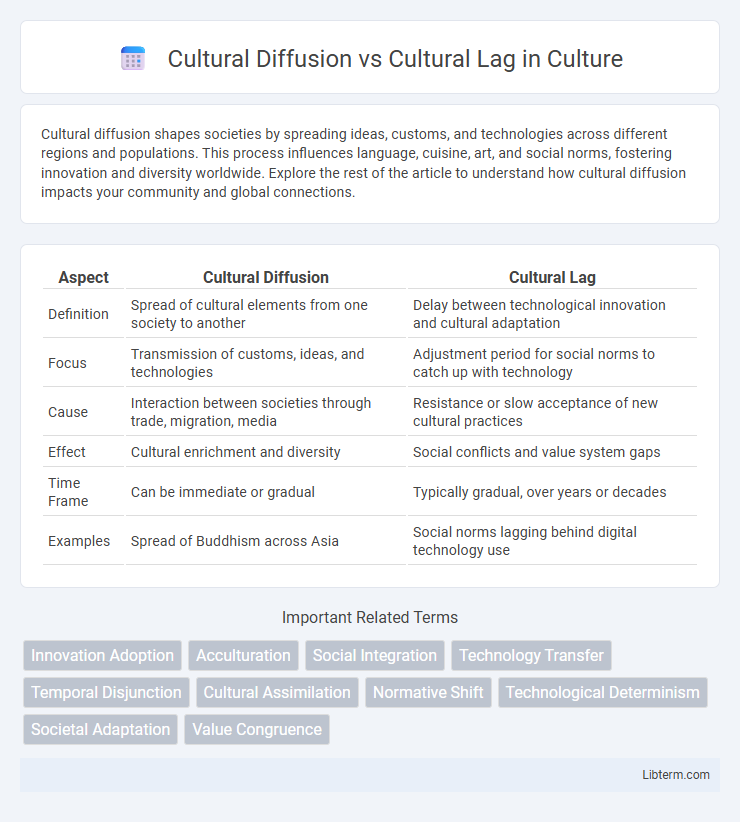Cultural diffusion shapes societies by spreading ideas, customs, and technologies across different regions and populations. This process influences language, cuisine, art, and social norms, fostering innovation and diversity worldwide. Explore the rest of the article to understand how cultural diffusion impacts your community and global connections.
Table of Comparison
| Aspect | Cultural Diffusion | Cultural Lag |
|---|---|---|
| Definition | Spread of cultural elements from one society to another | Delay between technological innovation and cultural adaptation |
| Focus | Transmission of customs, ideas, and technologies | Adjustment period for social norms to catch up with technology |
| Cause | Interaction between societies through trade, migration, media | Resistance or slow acceptance of new cultural practices |
| Effect | Cultural enrichment and diversity | Social conflicts and value system gaps |
| Time Frame | Can be immediate or gradual | Typically gradual, over years or decades |
| Examples | Spread of Buddhism across Asia | Social norms lagging behind digital technology use |
Understanding Cultural Diffusion
Cultural diffusion is the process through which cultural elements such as ideas, beliefs, technologies, and customs spread from one society or group to another, facilitating cultural exchange and innovation. It often occurs through trade, migration, communication, and media, leading to the blending and adaptation of cultural traits. Understanding cultural diffusion highlights how globalization and interconnectedness drive cultural diversity and social change across populations.
Defining Cultural Lag
Cultural lag occurs when non-material culture, such as beliefs and values, struggles to adapt to changes in material culture like technology or infrastructure. This delay creates social conflicts or inefficiencies as societal norms fail to keep pace with innovation. Understanding cultural lag is crucial for addressing the gaps between technological advancements and cultural adaptation in modern societies.
Key Differences Between Cultural Diffusion and Cultural Lag
Cultural diffusion refers to the spread of cultural beliefs and social activities from one group to another, promoting the exchange and adaptation of ideas, technologies, and practices. Cultural lag occurs when non-material culture, such as values and norms, fails to keep pace with changes in material culture, leading to social conflicts and adjustment delays. The key difference lies in diffusion facilitating cultural integration and innovation, while lag highlights the resistance and friction caused by slow cultural adaptation.
Historical Examples of Cultural Diffusion
Historical examples of cultural diffusion include the spread of Buddhism from India to East Asia through trade routes like the Silk Road, influencing art, architecture, and religious practices across China, Japan, and Korea. The Columbian Exchange in the 15th and 16th centuries facilitated the transfer of crops, animals, and technologies between the Americas and Europe, transforming diets and agricultural methods worldwide. These instances illustrate how cultural elements disseminate across societies, contrasting with cultural lag where technological advances outpace social adaptation.
Notable Instances of Cultural Lag
Cultural lag occurs when technological advancements outpace social or cultural adjustments, leading to significant societal tensions. A notable instance of cultural lag is the rise of the internet, where rapid digital innovation created challenges in adapting legal regulations, privacy norms, and ethical standards. Another example is the introduction of genetically modified organisms (GMOs), which advanced agricultural technology faster than public acceptance and regulatory frameworks could accommodate.
Factors Influencing Cultural Diffusion
Factors influencing cultural diffusion include geographic proximity, communication methods, and social networks that facilitate the spread of cultural traits. Technological advancements and trade also accelerate cultural exchange by connecting distant societies. Cultural diffusion contrasts with cultural lag, where social or technological changes outpace the adaptation of cultural practices.
Causes and Consequences of Cultural Lag
Cultural lag occurs when technological advancements outpace the social and cultural adaptations necessary for their integration, often caused by resistance to change, lack of awareness, or institutional rigidity. This lag results in social conflicts, ethical dilemmas, and disparities in resource distribution as societies struggle to reconcile new technologies with existing norms and values. Understanding cultural lag highlights the importance of proactive sociocultural adjustments to minimize disruptions in economic development and social cohesion.
Impact on Modern Societies
Cultural diffusion accelerates the exchange of ideas, technologies, and customs across global societies, fostering innovation and multicultural integration in modern urban centers. Cultural lag occurs when societal institutions or norms struggle to adapt to technological advancements, causing friction and social challenges in areas like law, education, and healthcare. The interplay of cultural diffusion and cultural lag shapes policy development, social cohesion, and economic progress in contemporary nations.
How Technology Shapes Diffusion and Lag
Technology accelerates cultural diffusion by facilitating rapid communication and the widespread exchange of ideas, customs, and innovations across diverse societies. However, cultural lag occurs when technological advancements outpace social adaptation, causing a delay in integrating new technologies into established norms, values, and institutions. The contrast between fast-moving digital innovations and slower societal acceptance highlights the ongoing tension between diffusion speed and lag in cultural evolution.
Addressing Challenges of Cultural Lag in a Globalized World
Addressing challenges of cultural lag in a globalized world requires proactive adaptation strategies that integrate technology and social practices at an equal pace, minimizing disparities between material innovations and non-material cultural responses. Developing inclusive policies that promote cultural awareness and education can facilitate smoother transitions and reduce resistance to change caused by outdated norms or beliefs. Emphasizing intercultural dialogue and flexible frameworks helps societies swiftly bridge gaps caused by delayed cultural adaptation, fostering social cohesion and sustainable progress.
Cultural Diffusion Infographic

 libterm.com
libterm.com